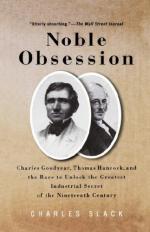|
This section contains 771 words (approx. 3 pages at 300 words per page) |

|
When rubber was first introduced to Europe from the New World, it was considered a marvelous novelty. Early explorers were amazed to find Caribbean natives playing games with bouncing balls made from the milky white juice (latex) of certain trees. A French explorer, Charles Marie de la Condamine, brought back samples of Indian-made rubber from the Amazon Valley in 1738 and set about promoting interest in the new substance. It was variously called caoutchouc (from the South American Indian word for it), gum elastic, and India rubber--"India" because the substance came from the West Indies, which Columbus thought were India, and "rubber" from the observation of British chemist Joseph Priestley (1733-1804) that the substance rubbed out lead pencil marks.
Europeans were fascinated with rubber's attributes: it was elastic, waterproof, strong, springy, and moldable. Since latex coagulates quickly, rubber always arrived in Europe in solid form, usually...
|
This section contains 771 words (approx. 3 pages at 300 words per page) |

|


